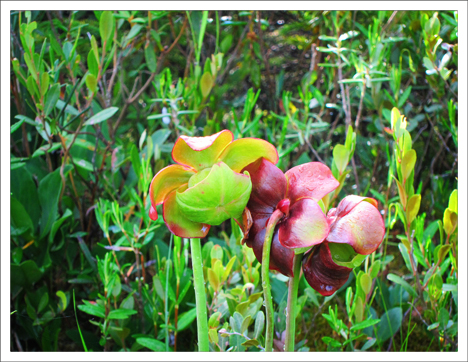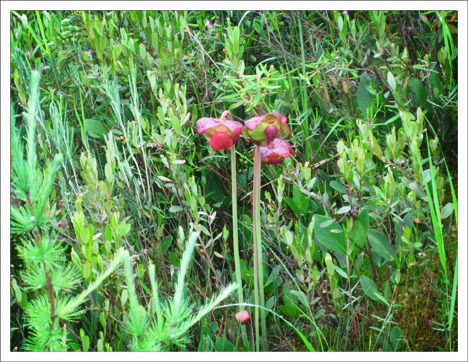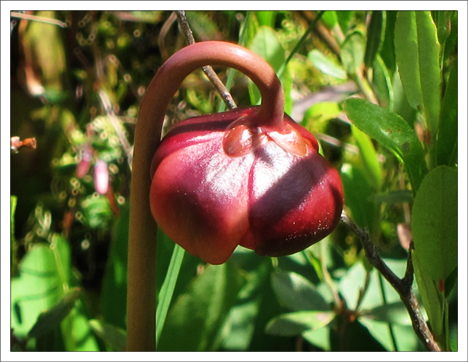Adirondack Wildflowers:
Pitcher Plant (Sarracenia purpurea)
 Adirondack Wildflowers: Pitcher Plant in bloom at the Paul Smiths VIC (13 July 2011)
Adirondack Wildflowers: Pitcher Plant in bloom at the Paul Smiths VIC (13 July 2011)
| This page is no longer being updated. For an updated and expanded version of this material, see: Pitcher Plant (Sarracenia purpurea) |
The Pitcher Plant is an evergreen carnivorous plant found in peat bogs in the Adirondacks. The plant produces large,nodding, deep red flowers in late spring and midsummer. The striking, dark-red flowers grow on leafless stalks up to two feet tall. Each flower is up to three inches wide.
The tubular leaves of the Pitcher Plant surround the base of the plant. The pitcher-like leaves are up to 8 inches long, usually purple-veined and have a broad, flaring lip lined with downward- pointing hairs. The leaves are often partly filled with water.
The Pitcher Plant is one of a number of plants, including the Sundew, which carry on photosynthesis like other green plants, but supplement their nutrition by capturing and digesting small insects. Insects enter the mouth of the plant and are trapped by the hairs. They then drown in the leaf fluid and are digested by enzymes and bacteria. The nutrients absorbed from the insects supplement the nutrients absorbed by the roots.
 Adirondack Wildflowers: Pitcher Plant on Barnum Bog at the Paul Smiths VIC (25 June 2012)
Adirondack Wildflowers: Pitcher Plant on Barnum Bog at the Paul Smiths VIC (25 June 2012)
The Pitcher Plant is common in saturated sphagnum mats in bogs, tamarack swamps and peaty areas in the Adirondack Mountains. The Pitcher Plant grows from Saskatchewan to Labrador and Nova Scotia; south through New England to Florida; west to Texas; north to Indiana, Illinois, and Minnesota.
Native American tribes reportedly used the Pitcher Plant to treat a variety of ailments, including lower back pain, fever, chills, whooping cough, pneumonia, kidney problems, and smallpox.
 Adirondack Wildflowers: Pitcher Plant on Barnum Bog (7 June 2012)
Adirondack Wildflowers: Pitcher Plant on Barnum Bog (7 June 2012)
Pitcher Plants are found at the Paul Smiths VIC in Barnum Bog, where they may be observed from the boardwalk on the Boreal Life Trail. Pitcher Plants also grow in the wetland areas around Black Pond and may be seen from the Black Pond Trail. These plants usually begin blooming in late May or early June.
References
- Lady Bird Johnson Wildflower Center. Native Plant Database.
- United States Department of Agriculture. Plants Database.
- Plants for a Future. Database.
- Flora of North America. Plant Database.
- US Forest Service Celebrating Wildflowers.
- University of Michigan. Native American Ethnobotany. A Database of Foods, Drugs, Dyes and Fibers of Native American Peoples, Derived from Plants.
- Anne McGrath. Wildflowers of the Adirondacks (EarthWords, 2000), p. 73.
- Doug Ladd. North Woods Wildflowers (Falcon Publishing, 2001), p. 62.
- Lawrence Newcomb. Newcomb's Wildflower Guide (Little Brown and Company, 1977), pp. 182-183.
- Roger Tory Peterson and Margaret McKenny. A Field Guide to Wildflowers. Northeastern and North-central North America (Houghton Mifflin Company, 1968) pp. 230-231.
- William K. Chapman, et al. Wildflowers of New York in Color (Syracuse University Press, 1998), pp. 52-53.
- Donald
D. Cox. A Naturalist's Guide to Wetland Plants. An Ecology
for Eastern North America (Syracuse University Press, 2002),
pp. 86-87.
